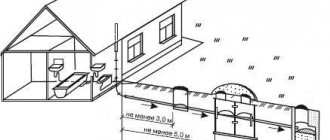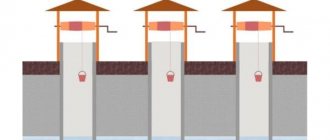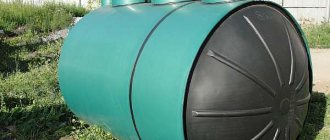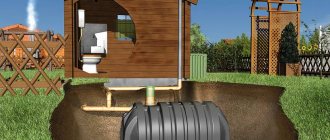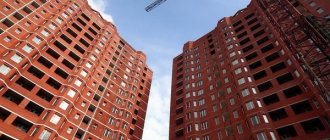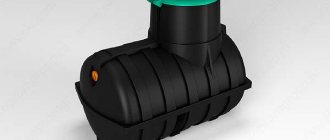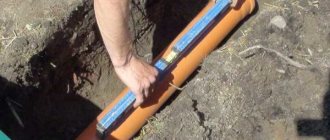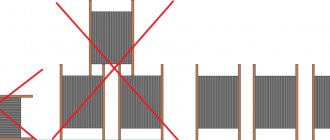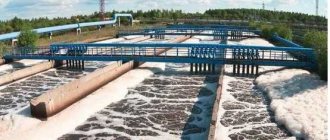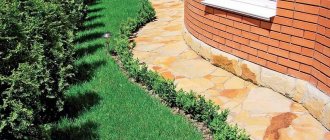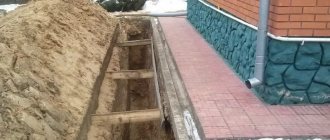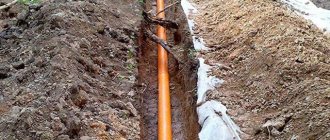Standards and requirements for security zones
Security zone of sewer networks
General regulatory requirements are presented in the following documents:
SNiP 40-03-99 - a newer version of SNiP 2.04.03-85 - basic design requirements SNiP 2.07.01-89* - all about the planning and development of populated areas SNiP 2.05.06-85* - standards related to main pipelines SNiP 3.05.04-85* - organizational issues and acceptance of work
The norms and sizes of protective zones for a certain region are adjusted and adopted by local urban or rural administrative authorities.
The security zone of sewer networks under normal conditions is established depending on the diameter of the pipes:
up to 600 mm - at least 5 meters from the walls of the pipeline 1000 mm and more - from 10 to 25 meters in each direction, depending on the purpose of the sewer network and the composition of the soil in which the pipeline is laid
When determining the size of security zones, special attention is paid to such parameters as:
seismological hazard actual humidity indicators
If the data is unfavorable, the size of the security zones is increased.
SNiP 2.07.01-89* clearly regulates the horizontal distance from underground sewerage networks to:
foundations of structures - 5 m for pressure and 3 m for gravity sewer networks axis of the outer rail of the railway track - 4 m curbs of the roadway - 2 m for pressure and 1.5 m for gravity sewers street lighting supports and contact networks - 1 m high-voltage network supports - 3m
Required distance between water and sewer lines
Water supply networks should be located above sewer lines. This is especially true at intersections of communications. If this condition cannot be met, then the sewer pipes are placed in a casing, the length of which depends on the type of soil. In loams and clays it should be 10 meters, and in sands - 20 meters. Crossing is allowed only at right angles.
Important! If it is necessary to repair a sewer or water supply at their intersection, you can use an excavator only to a depth that is one meter above the level of the upper wall of the pipe. Further excavation work is carried out manually without impact tools
The distance between the domestic sewage system and adjacent underground pipelines laid parallel within the city can be at least:
0.5 m - to underground cables 1 m - to heating networks 10 meters - with a diameter of 1000 mm From river banks - 250 m.
Important! It is recommended to increase all these distances by 10% due to the fact that the protective water zones on the diagrams do not always correspond to the actual sizes. Distance from the septic tank to the well and other objects
Distance from the septic tank to the well and other objects
There are different opinions among experts about what constitutes a sewerage protection zone. In practice, disagreements arise between local authorities and operating organizations. In this case, specialists from water utility companies will provide the correct arguments. Therefore, preliminary design, coordination and precise implementation of all requirements will prevent possible conflicts and ensure stable, trouble-free operation of the sewer collector for many years.
Distance between the septic tank and the water intake point
An important condition when placing a treatment plant on a site is to maintain a minimum distance from the designed object to the well or well.
Distances between the septic tank and the house
This requirement is explained by concern for the well-being of the population, since this measure prevents untreated wastewater from entering underground aquifers. Failure to comply with this norm can cause various diseases. Compliance with the requirement is also important when installing a septic tank, since, despite its tightness, emergency situations cannot be ruled out due to a burst pipe or depressurization of a connection.
For this reason, the distance from the septic tank or cesspool to the water intake point should be as wide as possible. The above documents determine that the distance of the site for the treatment plant from the point of water intake depends on the presence and quality of filter soil between the soil layer, where the final filtration of wastewater will occur, and the aquifer.
Determination of the filtering qualities of soil on a site is carried out through a hydrogeological study, which will allow one to assess the composition of the soil within the boundaries of the site. If the connection between these soil layers is not detected, then the distance between the water intake site and the cesspool cannot be less than 20 meters.
The higher the filtering capacity of the soil, the greater the minimum distance to the water intake point becomes. Sandy soil, as well as sandy and loamy soils, have the best filtering qualities. If there are soils of this type on the land plot, the distance separating the water intake and treatment plant should be from 50 to 80 meters.
When installing a septic tank or cesspool, regulations regarding distance from water pipes must also be observed. The distance to the pipes that supply drinking water to the house must be at least 10 meters. This requirement is put forward to protect the consumer in the event that a water pipe becomes depressurized so that wastewater cannot penetrate into it. In addition to the distance to the water intake point, the slope of the terrain must also be taken into account. The location for the treatment plant equipment must be below the water intake point.
Sanitary standards for water pipes
According to sanitary standards and rules, the sanitary zone is the distance that must be maintained from any pipe in which water is transported. Moreover, regardless of its personal or state affiliation, whether it is filled from underground or above-ground sources.
Replacement of sewerage pipeline
Since SanPiN, which defines the protective territory, was created on the basis of Federal Law No. 52, non-compliance with the requirements threatens serious troubles for violators of existing rules. In this regard, it is worth noting the following:
- missing or created in violation of existing standards, protected areas and sanitary water supply zones are punishable by a fine, often quite significant for the budget;
- the operation of communications, in accordance with existing regulations, is regulated by the Code of Administrative Offenses (CAO);
- Violation of sanitary zones of reservoirs and other water supply sources can amount to up to 40 thousand rubles for legal entities, and up to 2 thousand rubles for individuals. and more depending on the severity of the offense committed;
- the water supply area cannot be used for any type of construction or reconstruction, unless we are talking about structures that are directly important for its functioning or protective measures of a sanitary and epidemiological nature;
- the water supply zone presupposes the absence in the immediate vicinity of sewerage, wastewater, and agricultural land in which pesticides are used;
- Strict restrictions are imposed on proximity to garbage dumps, burial of any type of waste, and even on logging, unless it is unsanitary.
Old pipes
The Russian government has adopted a number of resolutions and documents that show that the concept of “protection zone” applies not only to water intake. The entire path of water transportation through the water supply system, starting from the source and further along its entire length, is subject to protective measures.
However, from a legal point of view, the Sanitary Protection Zone (or SZZ) created during water supply depends on several components.
In particular, the source of water - underground or aboveground, the level of natural protection available in a particular case. As well as the epidemiological and environmental situation and hydrogeological conditions on the site or in a particular area.
Water supply to the city
Standards for maintenance and repair work
Sewage is a developed engineering system that periodically requires repairs. The loads on pipelines or equipment are quite large, and problems that arise become noticeable at a later stage. Prevention does not always eliminate the failure of individual elements. Therefore, regulatory documents have been created for the repair of sewerage networks, which clearly define the order and priority of all activities.
Problems in the operation of drainage lines negatively affect the quality of wastewater treatment. Therefore, control and timely restoration of pipelines are strictly regulated by both technical and sanitary requirements. Any detected malfunction must be corrected immediately in accordance with instructions and technical regulations. Particular attention is paid to wastewater networks of industrial enterprises. If the technology involves aggressive compounds, toxic or active substances, the condition of the pipes is constantly monitored by special monitoring devices.
The condition of pipelines requires special attention. the appearance or growth of deposits on the pipe walls poses a threat to the operation of the entire line. Bandwidth decreases, network operation mode changes. With increasing layers, there is a possibility of blockages and complete blockage of the pipe lumen. Regulatory documents for flushing external sewers determine the criteria and frequency of measures for cleaning the network cavity from deposits. A specific cleaning method and the number of activities per unit of time are indicated. Particular attention is paid to pressure pipelines, the condition of which requires constant monitoring and control. An accident on a line under pressure will stop the sewer system for a long time and will require lengthy, expensive repairs. Such incidents cannot be allowed to occur, therefore special standards for flushing pipelines have been developed.
Sanitary protection zone of water supply and sewerage
If the water supply runs through undeveloped areas, then the width of the protective strip (sanitary protection zone) depends on the quality of the soil and the diameter of the pipeline:
- in dry soils - 10 m with a diameter of up to 1000 mm and 20 m with large pipe sizes;
- in wet soils - at least 50 m.
- A water pipeline whose protection zone runs in development sectors may carry additional environmental and production loads. The water supply protection zone in development areas can be reduced in agreement with the SES authorities. A mandatory minimum is established by law, which cannot be reduced under any circumstances:
- from the foundation of buildings and structures - at least 5 m;
- from the foundations of fences, overpasses, supports - at least 3 m;
- from the side stone of the street - at least 2 m;
- from the supports of overhead power lines - from 1 to 3 m, depending on the power of the network.
Thus, the security zones of water supply and sewerage vary in width depending on external factors.
Rules for the protection of main pipelines
The arrangement of main pipelines must comply with the provisions of Resolution No. 9 of the Gosgortekhnadzor of Russia dated April 24, 1992, “Rules for the protection of main pipelines.” This decree prescribes security zones for various types of main pipelines. For objects of various purposes, their own protection zone regime is determined, which contains restrictions regarding the land plot adjacent to the place of use.
Objects with open and underground water supply sources have sanitary zones, for which the boundaries are set taking into account the soils of the underground areas. Water supplies for various facilities must be planned and developed simultaneously with sewerage projects.
Sanitary protection zone (Design of sanitary protection zones)
Watch this video on YouTube
According to the rules in the security zone it is prohibited:
- unauthorized planting of trees;
- digging holes and trenches;
- storage and dumping of garbage, firewood, and other materials;
- performing pile driving work;
- carrying out blasting operations;
- earthworks for various purposes related to the movement of soil;
- equip permanent or temporary road surfaces from reinforced concrete slabs;
- carry out work blocking access to water supply and sewerage pipelines.
Dimensions of protected areas
According to SNiP, protective zoning of water supply facilities is formed from 3 zones:
- Strict regime.
- Restrictive.
- Observant.
Sanitary belt No. 1 is responsible for protecting water intake sites and structures for this purpose from any actions that could cause harm. Belt No. 2 protects water sources from microbiological contamination. Observation belt No. 3 monitors the level of chemical pollution. According to hygienic standards, sanitary zoning for open and underground water supply sources has different sizes.
The strict regime open source belt is determined by adding 200 m of adjacent territory upstream and 100 m downstream. For underground sources, belt No. 1 is no less than:
- 50-60 m around small wells;
- 25 m for deep wells.
The 2nd and 3rd zones of the sanitary protection zone are determined by specialists using a complex method using hydrodynamic calculations. They take into account the survival time of microbes for the restrictive belt. For observational zoning, the range of distribution of chemical compounds, while their composition in water is considered stable.
What does violating norms and requirements lead to?
Punishment for non-compliance with the rules of sanitary zoning of water supply networks is regulated by the Code of the Russian Federation “On Administrative Violations” dated December 30, 2001 No. 192-FZ. Contamination of water sources and areas of sanitary protection belts can lead to contamination of drinking water. And this, in turn, can cause the spread of epidemics and mass diseases of people. Penalties apply to:
- individuals (citizens);
- officials;
- legal entities (firms and companies).
Administrative liability for non-compliance with the rules and requirements for sanitary water supply areas is as follows - sanctions are imposed on those responsible in the form of a fine:
- for a private person - 500-1000 rubles;
- officials - 1000-2000 rubles;
- firms and companies - 10-20 thousand rubles.
Part 3. Distance from the septic tank to the water supply source.
It is extremely important to place the septic tank or other treatment facility at a safe distance from the well or borehole so that the treated wastewater does not enter the water supply. Neglecting the distance from the septic tank to the well and well exposes users of the water supply to serious danger. Let's look at what SNiP, SP, SanPiN regulate this issue and what requirements they impose.
Let's start with the provisions of the “Sanitary Protection Zone of Water Supply Sources and Drinking Pipelines. SanPiN 2.1.4.1110-02", you can find similar requirements in earlier documents, for example, "Recommendations for hydrogeological calculations to determine the boundaries of the 2nd and 3rd zones of sanitary protection zones of underground sources of domestic and drinking water supply", but we will focus specifically on SanPiN , since it is newer.
"2.2.1. Borders of the first belt
2.2.1.1. Groundwater intakes should be located outside the territory of industrial enterprises and residential buildings. Location on the territory of an industrial enterprise or residential development is possible with proper justification. The boundary of the first zone is set at a distance of at least 30 m from the water intake
- when using protected groundwater and at a distance of at least 50 m - when using insufficiently protected groundwater.
The boundary of the first zone of the WSS group of underground water intakes must be at a distance of at least 30 and 50 m from the outer wells.
For water intakes from protected groundwater located on the territory of a facility that excludes the possibility of contamination of soil and groundwater, the size of the first zone of the ZSO may be reduced subject to a hydrogeological justification in agreement with the center of state sanitary and epidemiological supervision.
2.2.1.2. Protected groundwater includes pressure and non-pressure interstratal waters that have a continuous impermeable roof within all zones of the Western Zone, excluding the possibility of local recharge from overlying insufficiently protected aquifers.
Insufficiently protected groundwater includes:
a) groundwater, i.e. groundwater of the first free-flowing aquifer from the surface of the earth, receiving recharge in the area of its distribution;
b) pressure and non-pressure interstratal waters, which, under natural conditions or as a result of the operation of a water intake, receive nutrition in the area of the WSS from overlying insufficiently protected aquifers through hydrogeological windows or permeable roof rocks, as well as from watercourses and reservoirs through direct hydraulic connection.”
In general, the requirements of this standard apply more to centralized water supply sources. It is almost impossible to comply with the requirements of this SanPiN within the framework of an ordinary summer cottage, because even the first sentence states that the groundwater intake should be located outside the residential area, and the size of only the first sanitary protection zone is unlikely to be observed within the framework of an ordinary area of a country house. And this is only the first zone, in the text of the document you can familiarize yourself with the measures for the first and second belt; most likely, your site will not allow you to comply with the requirements of this SanPiN.
The next document that you should pay attention to is “ SP 42.13330.2011 Urban Planning. Planning and development of urban and rural settlements. Updated version of SNiP 2.07.01-89* (with Amendment)" (valid)
We have already referred to this document above when we examined the requirements for the distance from the toilet to the house. Both requirements are noted in one paragraph, so we will repeat it. Let us note again that we are talking here about the toilet, and not about the septic tank.
According to clause 7.1:
“...In the absence of a centralized sewerage system, the distance from the toilet to the walls of the neighboring house must be at least 12 m, to the water supply source (well) - at least 25 m.”
This is how distances from septic tanks and other sewerage structures are regulated in “SP 53.13330.2011 Planning and development of territories of gardening (dacha) associations of citizens, buildings and structures. Updated version of SNiP 30-02-97*"
“6.8 The minimum distances between buildings for sanitary conditions should be, m:
from a residential building or residential building to a shower, bathhouse (sauna), toilet - 8;
from the well to the latrine and the composting device - 8.
The specified distances must be observed between buildings located on adjacent areas.”
It is important to understand that we are talking about a restroom, and not about a septic tank or other treatment facility.
Another interesting point of the same standard:
“8.1 The territory of a gardening and dacha association must be equipped with a water supply system that meets the requirements of SP 31.13330.
The supply of household and drinking water can be made both from a centralized water supply system, and autonomously - from shaft and shallow-tube wells, spring wells, in compliance with the requirements set out in SanPiN 2.1.4.1110.
The installation of water supply in residential buildings and residential buildings in accordance with SP 30.13330 is allowed if there is a local sewerage system or when connected to a centralized sewerage system.”
Here the standard refers to SanPiN 2.1.4.1110, the norms and requirements of which are almost impossible to comply with within the framework of a summer cottage.
In general terms, the issue of the distance from the well to the septic tank is described in TSN VIV - 97 MO (not valid):
“2.41. The procedure for determining the boundaries of water intake zones for surface and groundwater and their approval is regulated by SaN PiN 2.1.4.027-95.
The dimensions of the sanitary protection zone should be determined in accordance with the “Recommendations for hydraulic calculations for determining the boundaries of the second and third zone of sanitary protection of sources of domestic and drinking water supply” (VNII VODGEO 1983).
2.42. If it is impossible to isolate waste water, certified wastewater treatment plants should be used that exclude contamination of the aquifer according to sanitary-chemical and bacteriological indicators.”
But in “TSN EK -97 MO NORMATION AND STANDARDIZATION TERRITORIAL BUILDING STANDARDS” (not valid) the issue of placing a septic tank from a well is described in more detail:
"3.4.26. Sanitary gaps between water intake structures and soil treatment structures, depending on their productivity and location in relation to the direction of groundwater flow, should approximately be:
Table 3.4.1
Capacity Location of treatment facilities
cube meters per day downstream against the current perpendicular to the current
up to 4 40-50 m 20-25 m 25-30 m
up to 8 75-80 m 25-30 m 30-35 m
up to 12 80-85 m 30-35 m 35-40 m
up to 25 85-100 m 35-40 m 40-50 m
- For individual drainage systems with a limited plot of land with sandy and sandy loam soil, sanitary gaps can be reduced to 30, 15 and 19 m when soil treatment facilities are located, respectively, downstream, against and perpendicular to the flow of groundwater.”
Also very interesting is the mention of a septic tank and a filter well in the textbook “Water Disposal and Wastewater Treatment” by Yu. V. Voronov: “Filter wells, as a rule, are used for soil treatment of wastewater after a septic tank at flow rates of up to 1 m3/day.
... The effect of wastewater treatment in terms of total BOD and suspended solids in the filter well can reach 100%.”
A similar statement is given for underground filtration fields after a septic tank:
“Underground filtration fields are used on sandy and sandy loam soils and are a system of irrigation pipes laid to a depth of 0.6 - 0.9 m, but not less than 1 m above the groundwater level. The drainage system with underground filtration fields includes: a septic tank, dosing and distribution devices, and a network of irrigation pipes. ...The effect of wastewater treatment in terms of total BOD and suspended solids in underground filtration fields is up to 100%.”
This information allows us to say that systems based on septic tanks and soil filtration structures are among the most effective.
To summarize, it can be noted that all of the listed standards impose strict requirements on the location of the septic tank and other treatment facilities in relation to wells and boreholes. Unfortunately, it is not always possible to comply with these requirements on an ordinary summer cottage. In addition, the distance from the septic tank to the well may depend on many factors, individual for each individual case, ranging from the design and volume of the septic tank, ending with the nature of the soil and the depth of groundwater. Therefore, in practice, owners of country houses are guided by common sense and try to locate wastewater treatment plants as far as possible from their own and neighbors’ water supplies.
The most acceptable standard, from the above SNiP, SP, SanPiN, indicates a distance of 15 m for soil filtration structures under favorable conditions and 25 m for a “toilet”. All that remains is to focus on these numbers. Thus, the septic tank should be located as far as possible from the source of water supply (your own and your neighbors), it is also important that the septic tank is located lower in relief from the source of water supply.
What is a protected area
A security zone is one of the types of zones with special conditions for the operation or protection of certain territories, the size and content of which are regulated by the current legislation of the Russian Federation. The concept of a protected area includes:
- actually, security (ensuring the integrity and absence of damage to both the structure itself and the potential harm that the object protected by fencing or legal norms may cause;
- the sanitary protection zone performs a dual function - sanitary, anti-epidemiological and protective - protection and removal from structures that pose a potential threat of damage;
- water protection zones that prevent pollution of water bodies from which the population is likely to be supplied with water;
- sanitary protection zones for sources of drinking water and liquids for household supplies;
- other protection zones - near airfields, floods, protected cultural and historical sites.
Work on laying sewerage in the city
The purpose of the legislative restriction carried out at the federal level is to approve special operating conditions or exclude them from use other than for their intended purpose. The distance at which objects should be located from areas of cultural or historical heritage may be determined by a regional government decree.
Fishing and water protection territories and their delimitation are fixed at the level of federal legislation. How many meters in each direction is the security zone of gas and oil pipelines, oil product and ammonia pipelines, pipelines to fully satisfy the household needs of the population is determined by the relevant SNiP, SanPiN and SP.
Protected area
Features of sanitary requirements for drainage lines
Sanitary requirements for sewerage are divided into several sections:
- household (household, household and fecal systems);
- industrial (technically, systems are divided into subtypes based on the content or consistency of waste);
- stormwater (discharge of rain and melt water from urban areas and industrial sites).
Along with the general requirements, each of these systems has its own rules and regulations. The main task is to control the condition of wastewater that is discharged into water bodies. They are sources of drinking water for populated areas, so control of the quality of wastewater begins long before it enters treatment plants.
There are several types of sewer networks:
- alloy;
- separate (full or incomplete);
- semi-separated.
The difference between them lies in the method of transporting wastewater to treatment plants. All-alloy technology is designed for joint transport of domestic, storm or industrial wastewater to treatment facilities. This technique is only suitable for settlements that do not have hazardous industries or large volumes of waste liquids.
If a settlement contains hazardous industries, SanPiN “water and sewerage” requires the use of a separate drainage system. One collector is built for household waste, and its own pipelines for industrial or storm waste. Wastewater treatment is also carried out by different complexes. This method requires high construction costs. But the quality of cleaning increases significantly. In addition, it becomes possible to use special treatment complexes to treat wastewater from different systems. Typically, waste from industrial sites has a stable composition, so certain treatment technologies can be used. The same approach can be used for stormwater or sanitary systems.
Semi-separate networks are designed for transporting domestic and rainwater. If the volumes are relatively small and the level of impurities is high, the liquids are sent to treatment facilities. However, during heavy rainfall, when the collector is filled primarily with rainwater, emergency discharge into water bodies without treatment is allowed. SanPiN for sewerage allows this option for the operation of complexes if they do not contain harmful or toxic components. The technique allows you to unload equipment, avoid overloading treatment facilities, and increases their efficiency.
Also read: Repairing a sewer pipe without dismantling: ways to repair it
How to lay a sewer in relation to a water supply
The installation of sewer and water supply systems in a private house is regulated by the requirements of SNiP. Water supply and sewerage pipes must be placed in parallel.
The distance between utility networks made of plastic pipes is 1.5 m. If a cast iron water supply and sewer pipe with a diameter of more than 20 cm is laid, the distance between them is 3 m. If the diameter of cast iron pipes is less than 20 cm, the distance between them is 1. 5 m when laying networks nearby. The use of asbestos-cement and reinforced concrete pipes for water supply requires laying them at a distance of 5 m from the sewer.
Secrets of introducing water supply and sewerage into the house
Watch this video on YouTube
Responsibility for non-compliance with security rules
In case of non-compliance with the rules of protective zoning of water bodies, liability is provided with the imposition of an administrative penalty. Anyone who commits a violation pays a fine in the amount of:
- private person - 1500-2000 rubles;
- representatives of firms and companies - 3000-4000 rubles;
- firms and companies - 30-40 thousand rubles.
The territory of protective zone No. 1 is necessarily fenced and strictly guarded. Warning signs are installed along the entire perimeter of the fence.
Possible consequences of non-compliance with the required standards
As a result, excavation work is carried out in a certain area without realizing that it is located in a security zone. In this case, it is possible to cause harm to the environment, serious damage to sewer networks or facilities, leading to property damage, significant losses and material costs for restoration.
promptly remove garbage, and in winter, snow and ice, ensuring unimpeded access to sewerage facilities, invite a representative of the organization that issued the permit to the procedure for handing over the facility
These responsibilities apply to all contractors performing work in open areas and areas in protected zones.
The concept of a security zone
Any sewer system is a potential source of hazard to drinking water or the surrounding area. To prevent their contamination by sewage, security, or sanitary, sewerage zones are provided.
Pumping stations, treatment plants and other sewerage facilities have their own regulatory indicators, depending on the size of the buildings, their purpose and location. Information about their boundaries can always be obtained from local governments and specialized organizations, as well as from design bureaus.
plant trees at a distance of less than 3 meters from collectors, cut or add soil, use impact mechanisms and drilling rigs, block access to structures, carry out lifting and construction work without appropriate permission
Accident of external sewer systems
Accidents of external sewer systems occur much more often than in water supply networks, power supply and communication lines. This is due to the fact that sewer protection zones do not have warning signs. Organizations operating engineering communications are required to notify about the presence of electrical cables in the serviced area with appropriate stationary signs, but this does not apply to sewerage.
A thorough study of the area where you plan to carry out certain work will help you avoid getting into a difficult situation. A sign of the presence of sewerage networks on the territory are the wells located on it, the covers of which are marked in the form of a large letter “K”. It is necessary to order a utility plan from specialized organizations (design institutes, local administrations, Vodokanal trusts) and carefully read it, analyze security zones, obtain the appropriate permits, and consult with specialists.
It is prohibited to carry out work in sewer security zones without special permission. After receiving the appropriate permit, the contractor is obliged to:
adhere to strict compliance with norms, requirements and rules; ensure the safety of sewer pipelines and structures, as well as their integrity; take all possible precautions, suspending work if any inconsistencies are discovered in the documents and permits provided to him
average temperature main characteristics of the soil of overpasses, fences, supports - 3 and 1.5 m, respectively, outer edge of the ditch - 1 m
In some cases, the distance is reduced or increased after making final calculations and deciding on the justifications.
Joint laying of underground pipelines
SNiP standards stipulate the distance between water supply and sewer pipelines and the requirements for their relative position.
1.5 - 5 m - to the water supply system, depending on the material of manufacture and the diameter of the pipes 0.4 m - to the rainwater drainage system 1 to 5 m - to the gas pipeline, depending on the pressure
When water supply and sewer main networks are located longitudinally, the following distances are maintained:
20 meters - with a diameter of more than 1000 mm 50 meters - when laying highways in wet soils
It is prohibited to locate sewerage networks in sanitary areas of water mains.
Sewage collectors in water protection zones should be located at a distance:
From the lakes - 100 m from the water border. From underground sources - 50 meters or more.
kanalizaciyainfo.ru
Selecting a location
Sanitary organizations strictly monitor the distance from the cesspool to the facade of residential and non-residential premises, as well as wells and other bodies of water on the site. Special norms have been developed that specify standard requirements. They are prescribed in the Sanitary Rules for the Maintenance of Populated Areas No. 42-128-4690-88 and SNiP 30-02-97 :
- The minimum permissible distance from the facade of a residential building is 15 meters. Please note that if the basement exceeds the area of the building, then the countdown is from the basement wall;
- A distance of 10 meters or more (if possible) should be maintained from non-residential premises and buildings located on another site. If these standards are not met, then the owner of the neighboring plot has the right to sue. Penalties are provided as punishment;
- If there is a well or borehole on the site, then a distance of 20 meters is maintained from them. Here the standards differ, because the footage depends on the groundwater level. The higher it is, the greater the distance. If the area is swampy, then a cesspool is not allowed. At the same time, on sand the minimum permissible distance is 50 meters. This is due to the high throughput of sand;
- There should be at least 1 meter from the road or fence.
Layout of the cesspool
Regardless of the distance, before starting the preparation of the pit, its depth is calculated. The lower boundary of the pit should be 50% below the level of drinking groundwater. This information can be obtained from your local geological organization.
Permissible depth standards
Here:
- 1 – top layer of soil (chernozem);
- 2 – crushed stone backfill of the pit for compaction;
- 3 – drains;
- 4 – crushed stone cushion at the bottom of the pit.
